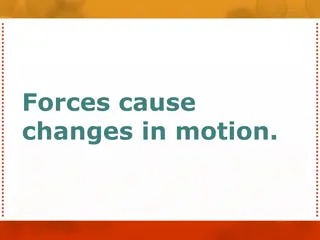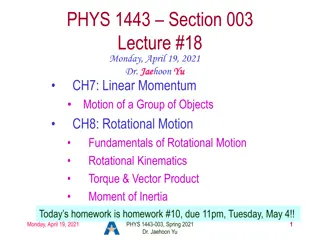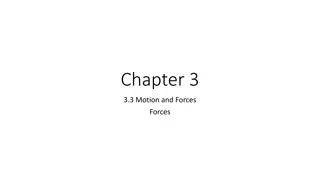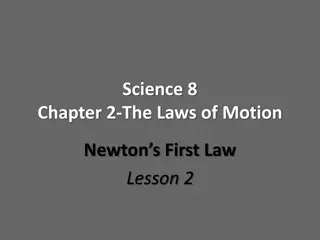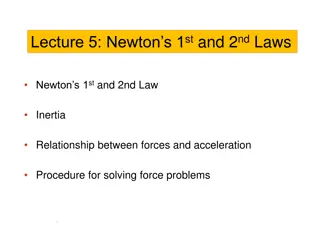Exploring How Forces Influence Object Motion
Understanding the concept of forces is essential in predicting the motion of objects. Through practical experiments with cotton balls and a fan, students observe the effects of forces like gravity and air resistance on object motion. By documenting their predictions and observations, students gain valuable insights into how forces shape the movement of objects in everyday scenarios.
Download Presentation

Please find below an Image/Link to download the presentation.
The content on the website is provided AS IS for your information and personal use only. It may not be sold, licensed, or shared on other websites without obtaining consent from the author. Download presentation by click this link. If you encounter any issues during the download, it is possible that the publisher has removed the file from their server.
E N D
Presentation Transcript
FORCES LESSON 6A How Can Ideas about Forces Help Us Predict the Motion of Objects?
Review: Forces What is a force? Why do you think it s important to learn about forces? What about gravity and friction? How might an understanding of forces help you in your everyday life?
Todays Focus Question How can ideas about forces help us predict the motion of objects?
Cotton Balls in the Wind Photo courtesy of BSCS
Your Predictions about the Cotton Ball What do you predict will happen when a cotton ball is dropped in front of a fan that s rotating at full speed? Draw a picture in your science notebook showing how you think the cotton ball will move when it s dropped in front of the fan. For now, just think about the motion of the cotton ball, not the forces acting on it.
Share Your Predictions What do you predict will happen when a cotton ball is dropped in front of a fan that s rotating at full speed? Share your predictions and drawing with an elbow partner. Describe how you think the cotton ball will move when it s dropped in front of the fan and why you think so. Don t talk about forces right now.
Investigation: Cotton Balls in the Wind A few volunteers will drop small cotton balls in front of the rotating fan one at a time. Carefully observe the motion of each cotton ball when it s dropped in front of the fan. Be prepared to share your observations with the class. I ll record your observations on chart paper so we can track how the cotton balls moved and see if we can identify any patterns.
Investigation: Cotton Balls in the Wind Do you agree or disagree with this pattern of motion based on our observations? 1.When the cotton ball was dropped, it fell toward the ground. 2.When the fan blew on the cotton ball, it moved forward, but it also continued falling toward the ground. 3.When the cotton ball hit the ground, it stopped moving.
Describe the Forces How might the science idea of forces help us explain why the cotton balls moved the way they did? Use the foam arrows to describe the forces acting on each cotton ball. Why did the cotton ball initially fall toward the ground? Why did the cotton ball move forward when the wind from the fan hit it? Why did the cotton ball continue falling downward and then stop when it hit the ground?
Forces Acting on the Cotton Ball Step 1:Gravity pulls the cotton ball toward the ground. Step 2: Air from the fan pushes the cotton ball horizontally while gravity keeps pulling it down. Step 3: Friction between the cotton ball and the floor slows the cotton ball to a stop after it hits the ground.
Lets Summarize! Today s focus question: How can ideas about forces help us predict the motion of objects? Think-Pair-Share: What have you learned about forces in this unit that can help you predict the motion of objects? Think about this question. Then share with a partner how knowing about forces helped you predict and describe the motion of a cotton ball in front of a rotating fan.
Key Science Ideas Forces are pushes and pulls that can change an object s motion. If we know the strength (size) and direction of the forces acting on an object, we can predict whether or not it will move and in what direction.
Next Time In our final lesson, you ll show what you know by acting out forces and the motion of objects in real-life scenarios! The Physics Players in Forces and Motion







